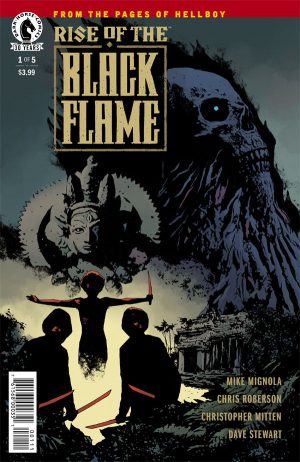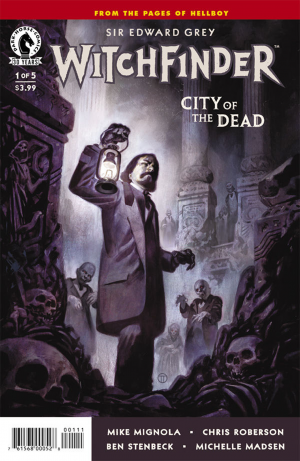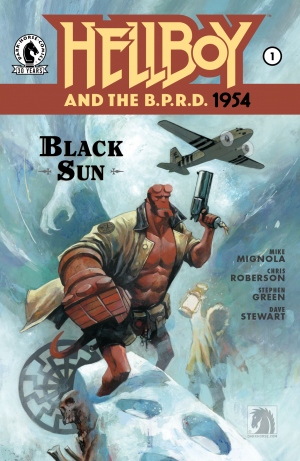I've never had the opportunity to read a whole lot of Mike Mignola stuff. I know that this is probably blasphemy from a comic reviewer, but I simply never had the opportunity or drive like I did with other titles, which is why I decided to review this book, Rise of the Black Flame.
To begin, the cover is creepy and reminiscent of other Mignola story covers I've seen in the past. The cover, art by Lawrence Campbell and Dave Stewart, shows a skull emerging from a mountain top above an ancient jungle temple, some kind of strange statue and three figures shrouded in shadow, only their knives highlighted in red. Very cool start to this book, as it sets a dark and foreboding tone.
 The inside credits page sets the stage for the story, telling how young girls are disappearing from cities across Burma. Our first story page starts out great, with some flashbacks of things we don't know about yet; a character looking somewhat like a smoldering Ghost Rider confronts a woman in June of 2014, below that the same character in March of 2006 is behind a horde of what I can only describe as big frogs with teeth and radioactive tongues. We then see the same character in October of 1944, simply telling someone “I am Death.” Finally, February 1932, where there is a meeting between this character and a few regular people. He doesn't strike me as the type to simply hang out with regular people, but who am I to judge.
The inside credits page sets the stage for the story, telling how young girls are disappearing from cities across Burma. Our first story page starts out great, with some flashbacks of things we don't know about yet; a character looking somewhat like a smoldering Ghost Rider confronts a woman in June of 2014, below that the same character in March of 2006 is behind a horde of what I can only describe as big frogs with teeth and radioactive tongues. We then see the same character in October of 1944, simply telling someone “I am Death.” Finally, February 1932, where there is a meeting between this character and a few regular people. He doesn't strike me as the type to simply hang out with regular people, but who am I to judge.
One final flashback leads us to May of 1923. We are in an ancient temple covered in roots and overgrowth. A lone monk speaks to the “Great Darkness”, and it is soon apparent that he, along with two masked and sword-wielding men, that they are going to sacrifice a young girl in order to revive this great darkness.
We are now in one of the British colonies of Burma. Police Sergeant Geoffrey Mcallister is investigating one of the disappearances of these young girls. The mother recaps the story of the young girl along with her caretaker are out visiting the gardens when, after a while, the caretaker was found murdered, and the girl was gone. Mcallister, along with his partner Sandhu, leave the house and discuss that although there is little hope of finding the girl, they must do their best.
We move along to a large building in which a mob has gathered out front. A man has been murdered, and our boys Mcallister and Sandhu arrive on the scene. Word from another policeman is that this guy tried to stop a man in a black hood from kidnapping a young girl, only to be strangled to death. The officer finds a coin from a neighboring country, freshly minted, which is the very first clue as to which direction to look in to find this kidnapper. Sandhu then reveals that he thinks it’s the work of a cult and goes on to describe the terrible things the cult used to do to travelers, including BUM, BUM BUUUUM blood sacrifices. This leads the two officers to go undercover and travel to Siam in order to find out more about this cult. It's here that, after some investigating, they encounter a woman that seems to be quite knowledgeable on such things as cults, monsters and the like...
This is my kind of story: a slow burn. The writers have given us just enough from the beginning to catch our attention: blood sacrifice to the “Great Darkness.” We then meet up with our two protagonists, two officers caught up in something much larger than themselves. They go on a journey to figure out what’s really going on... I speak of tropes a lot in my reviews. Is this a story I haven't heard before? No. This is a fairly typical setup, which is fine because it's all in the presentation for me. I found myself anxious to get to the next page or panel to see where the story was headed next. I'm also very interested in this “Black Flame” character, as anyone with a fiery skull for a head is a winner in my book.
The art was very classic looking and fit the time period of the story perfectly. Not overly detailed, which helped the overall atmosphere of the story, making it just feel like a classic story that's been around for years. Colors were a little muted and not vibrant, which drew me in more as it all felt so right. Overall a fantastic art style for this story.
This book has me very interested. Stories like this can always hook me in so long as they're done right. I will ding it a little for giving me that “I've read this before” feeling, though. Not that there's not enough new stuff here to make it different, but it's still not a completely original story by any stretch. Here's hoping that's just the first issue.
[su_box title="Score: 4/5" style="glass" box_color="#8955ab" radius="6"]
Rise of the Black Flame #1
Writers: Mike Mignola and Chris Roberson
Artist: Christopher Mitten
Colorist: Dave Stewart
Publisher: Dark Horse Comics
Price: $3.99
Format: Mini-Series; Print/Digital
[/su_box]





